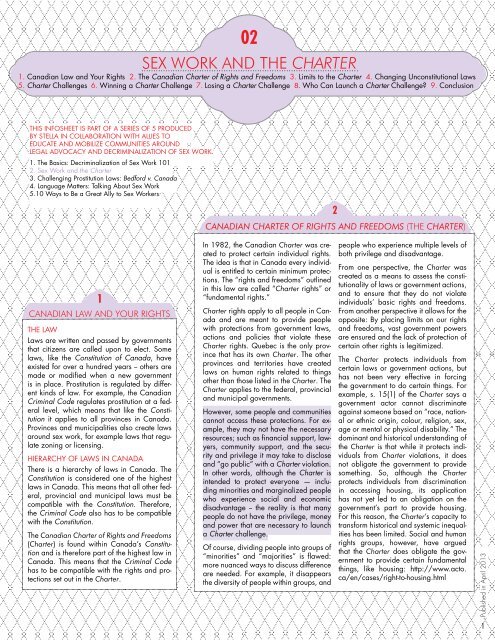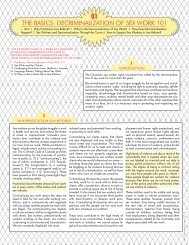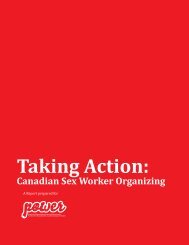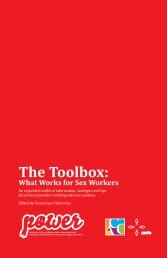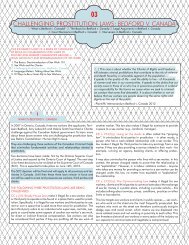SEX WORK AND THE CHARTER - Stella
SEX WORK AND THE CHARTER - Stella
SEX WORK AND THE CHARTER - Stella
- No tags were found...
You also want an ePaper? Increase the reach of your titles
YUMPU automatically turns print PDFs into web optimized ePapers that Google loves.
02<strong>SEX</strong> <strong>WORK</strong> <strong>AND</strong> <strong>THE</strong> <strong>CHARTER</strong>1. Canadian Law and Your Rights 2. The Canadian Charter of Rights and Freedoms 3. Limits to the Charter 4. Changing Unconstitutional Laws5. Charter Challenges 6. Winning a Charter Challenge 7. Losing a Charter Challenge 8. Who Can Launch a Charter Challenge? 9. ConclusionThis InfoSheet is part of a series of 5 producedby <strong>Stella</strong> in collaboration with allies toeducate and mobilize communities aroundlegal advocacy and decriminalization of sex work.1. The Basics: Decriminalization of Sex Work 1012. Sex Work and the Charter3. Challenging Prostitution Laws: Bedford v. Canada4. Language Matters: Talking About Sex Work5.10 Ways to Be a Great Ally to Sex Workers2CANADIAN Charter OF RIGHTS <strong>AND</strong> FREEDOMS (<strong>THE</strong> Charter)1CANADIAN LAW <strong>AND</strong> YOUR RIGHTSThe LawLaws are written and passed by governmentsthat citizens are called upon to elect. Somelaws, like the Constitution of Canada, haveexisted for over a hundred years -- others aremade or modified when a new governmentis in place. Prostitution is regulated by differentkinds of law. For example, the CanadianCriminal Code regulates prostitution at a federallevel, which means that like the Constitutionit applies to all provinces in Canada.Provinces and municipalities also create lawsaround sex work, for example laws that regulatezoning or licensing.Hierarchy of Laws in CanadaThere is a hierarchy of laws in Canada. TheConstitution is considered one of the highestlaws in Canada. This means that all other federal,provincial and municipal laws must becompatible with the Constitution. Therefore,the Criminal Code also has to be compatiblewith the Constitution.The Canadian Charter of Rights and Freedoms(Charter) is found within Canada’s Constitutionand is therefore part of the highest law inCanada. This means that the Criminal Codehas to be compatible with the rights and protectionsset out in the Charter.In 1982, the Canadian Charter was createdto protect certain individual rights.The idea is that in Canada every individualis entitled to certain minimum protections.The “rights and freedoms” outlinedin this law are called “Charter rights” or“fundamental rights.”Charter rights apply to all people in Canadaand are meant to provide peoplewith protections from government laws,actions and policies that violate theseCharter rights. Quebec is the only provincethat has its own Charter. The otherprovinces and territories have createdlaws on human rights related to thingsother than those listed in the Charter. TheCharter applies to the federal, provincialand municipal governments.However, some people and communitiescannot access these protections. For example,they may not have the necessaryresources; such as financial support, lawyers,community support, and the securityand privilege it may take to discloseand “go public” with a Charter violation.In other words, although the Charter isintended to protect everyone — includingminorities and marginalized peoplewho experience social and economicdisadvantage -- the reality is that manypeople do not have the privilege, moneyand power that are necessary to launcha Charter challenge.Of course, dividing people into groups of“minorities” and “majorities” is flawed:more nuanced ways to discuss differenceare needed. For example, it disappearsthe diversity of people within groups, andpeople who experience multiple levels ofboth privilege and disadvantage.From one perspective, the Charter wascreated as a means to assess the constitutionalityof laws or government actions,and to ensure that they do not violateindividuals’ basic rights and freedoms.From another perspective it allows for theopposite: By placing limits on our rightsand freedoms, vast government powersare ensured and the lack of protection ofcertain other rights is legitimized.The Charter protects individuals fromcertain laws or government actions, buthas not been very effective in forcingthe government to do certain things. Forexample, s. 15(1) of the Charter says agovernment actor cannot discriminateagainst someone based on “race, nationalor ethnic origin, colour, religion, sex,age or mental or physical disability.” Thedominant and historical understanding ofthe Charter is that while it protects individualsfrom Charter violations, it doesnot obligate the government to providesomething. So, although the Charterprotects individuals from discriminationin accessing housing, its applicationhas not yet led to an obligation on thegovernment’s part to provide housing.For this reason, the Charter’s capacity totransform historical and systemic inequalitieshas been limited. Social and humanrights groups, however, have arguedthat the Charter does obligate the governmentto provide certain fundamentalthings, like housing: http://www.acto.ca/en/cases/right-to-housing.htmlPublished in April 20131
3LIMITS TO <strong>THE</strong> CANADIAN <strong>CHARTER</strong>OF RIGHTS <strong>AND</strong> FREEDOMSAll laws and government practices in Canada must be compatible withthe Constitution, which includes the Charter. However, the governmentand the courts still have the power to uphold a law that violates a Charterright by using Section 1 of the Charter:Section 1 of the Charter: “The Canadian Charter of Rights and Freedomsguarantees the rights and freedoms set out in it subject only tosuch reasonable limits prescribed by law as can be demonstrably justifiedin a free and democratic society.”In other words, proving that a certain law or government action violatesa Charter right is not enough to force the government to change it, if thecourt decides that the Charter violation in question is “justified in a freeand democratic society.” So even if the court agrees that a certain lawor government action violates a Charter right, they still have the powerto say that it’s “justified” under s. 1, and therefore not unconstitutional.4CHANGING UNCONSTITUTIONAL LAWAn unconstitutional law can be struck down (meaning it is no longerin force), or changed to make it compatible with the Constitution andCharter. This process can happen in two ways:1. The government can initiate this. The legislators (the people whowrite the laws) can decide to modify the law by passing a Bill. Beforedoing so, the government can ask the Court for their opinion on thelaw’s constitutionality - this is called a “Reference”. Here’s an example:In 1990 the Manitoba government questioned whether the bawdyhouselaw and communicating law were unconstitutional (sections 193and 195.1(1)(c) of the Criminal Code at the time). They asked thecourts for their opinion. First, the Manitoba Court of Appeal, and thenthe Supreme Court of Canada (SCC). See the SCC decision at: http://scc.lexum.org/en/1990/1990scr1-1123/1990scr1-1123.htmlSpecifically, the government wanted to know whether these laws violatedthe right to freedom of expression and the right to liberty and securityof the person (rights protected by s. 2(b) and s. 7 of the Charter).The majority of the SCC decided that the bawdy-house law did notviolate s. 2(b) or s. 7 of the Charter. So, in their opinion this law wasnot unconstitutional and need not be changed. On the other hand, themajority decided that the communicating law did violate s. 2(b) of theCharter, but this violation was deemed to be justified under s. 1. So, intheir opinion, it also did not need to be changed.2. People who are not part of the government can also challenge theconstitutionality of a law or government practice by launching a Chaterchallenge.Some Rights and FreedomGuaranteed by the CharterFundamental FreedomsFreedom of conscience; freedomof religion; freedom of thought;freedom of opinion; freedom ofexpression; freedom of association.Democratic RightsRight to participate in politicalactivities; right to democracy; theright to vote and to be eligible forelection.Legal RightsRight to life, liberty and security ofperson; protection againstunreasonable and arbitrarydetention; upon arrest or detention,the right to counsel, the right to beinformed of that right, the right tosilence; rights in criminal and penalmatters, such as the presumption ofinnocence; the right to an intepreter;the right to equality; rightto equal treatment before the lawwithout discrimination (age,gender, race, etc.)Published in April 20132
5Charter CHALLENGESIf an individual’s or group’s protected Charter rights orfreedoms are being violated by a government law orpractice, they can try to initiate a Charter challenge. Thismeans taking the government responsible for the law orpractice to court.The individual or group who launches the Charter challengeis called the plaintiff or applicant. The plaintiff(s)has to demonstrate in court how the law or practice inquestion violates their Charter right(s). At the base ofevery challenge is a specific law(s) or practice that isbeing contested, and a specific Charter right(s) that theplaintiffs say have been violated.Many individuals and groups have challenged laws andgovernment actions under the Charter, including francophonecommunities, religious groups, a doctor whopractices abortion, men opposed to abortion, pilots,swingers, provincial governments, Indigenous people,LGBTQ communities, prisoners, and migrants. Includingthe current Bedford v. Canada case and the SWUAVv. Canada case, there have been three cases involvingsex work and the Charter that have been heard by theSupreme Court of Canada.Here are two examples of how our allied communitieshave launched Charter challenges:In a case called Little Sisters Book and Art Emporium v.Canada (2000), the plaintiffs claimed that a particulargovernment practice was unconstitutional – the way customsofficers treated the erotic material that Little Sistersimported to their store. The plaintiffs claimed that the customsofficials delayed, confiscated, destroyed and misclassifiedmaterials imported by the plaintiff’s bookstoreand treated the material differently than erotic materialimported by other businesses. They argued that this wasdue to the LGBTQ content of their material, and thereforeviolated their right to freedom of expression and freedomfrom discrimination (protected by s. 2(b) and s. 15of the Charter). Little Sisters can be found at: http://scc.lexum.org/en/2000/2000scc69/2000scc69.htmlIn the “Insite case”, the plaintiffs challenged parts ofthe Controlled Drugs and Substances Act that prohibitspossession and trafficking of illegal drugs. They arguedthat these laws violated their right to security ofthe person and liberty (protected by s. 7 of the Charter),by preventing them from operating a supervised injectionsite. The plaintiffs did not demand that the challengedlaws be repealed, but that they should not applyto people in their particular safe injection site. In thiscase, the SCC agreed with the plaintiffs and decidedthat the violations were not justified. The plaintiffs wontheir right to operate a safe injection site. In other words,people using the site can no longer be arrested underthe Controlled Drugs and Substances Act. The case,Canada (Attorney General) v. PHS Community ServicesSociety (2011) can be found at: http://scc.lexum.org/en/2011/2011scc44/2011scc44.html6winning a charter ChallengeWhen a case goes all the way to the Supreme Court ofCanada (SCC), the decision is final. If the SCC decidesthat a certain law is unconstitutional and cannot be justified,judges are required to do whatever it takes to fix theunconstitutional law. Various things can happen:First, they can “strike down” the law – meaning that thelaw is no longer in force and cannot be applied.Second, they can strike down the law but hold off onmaking the law invalid, to give Parliament time to changethe law.Third, the court might “read in” or “read down” a law– meaning they change or reinterpret part of the law sothat it either no longer violates someone’s Charter rights,or reduces the violation to a level that the court finds acceptable.When the courts or Parliament re-write a law, unless theyfully grasp the Charter violation that they are attemptingto repair, the new or changed law could be equally problematicfor the plaintiffs.77Losing a charter ChallengeIf the court rules against the plaintiff and the plaintiff canno longer appeal the decision – either because their appealis rejected or because it’s the SCC’s final decision– the law or practice remains as is (“status quo”).This is damaging for the people and communities whosupported the Charter challenge. Not only does the lawremain in effect but also if the court decides that the contestedlaw or practice is constitutional, it will be very difficultto challenge it again (at least for many years).The court’s decision reinforces the idea that the law orpractice is legitimate. This can have harmful social impactssuch as reinforcing public perspectives that devaluethe plaintiffs and legitimize the discrimination and stigmathat they face.That being said, in exceptional cases Parliament could bepersuaded to modify a law due to public pressure, evenif the SCC had previously decided the law was constitutional.Published in April 20133
8who can launch a Charter CHALLENGE?Not everyone can launch a Charter challenge and sue the government.The plaintiff has to get “standing”. This is the legal right to challenge alaw in court – think of the “right to stand in court” or “have a legal leg tostand on”. It’s understandable that there would be some parameters asto who can launch a challenge, but not everyone agrees on what theselimits should be.Basically, there’s private interest standing and public interest standing,and the plaintiff or applicant has to succeed in convincing the court thatit is one of the two to launch a Charter challenge.In Bedford v. Canada, Justice Himel decided that all three individualsex workers (“plaintiffs”) had private interest standing and were able tolaunch their Charter challenge.In SWUAV v. Canada (Downtown Eastside Sex Workers United AgainstViolence Society & Sheri Kiselbach v. Canada), standing was used as abarrier to block sex workers from challenging prostitution laws. The plaintiffsare a collective of sex workers who live in Vancouver’s DowntownEastside, and Sheri Kiselbach is a former sex worker. They claim that avast range of the criminal prostitution laws violate their ss. 7, 2(b), 2(d) &15 Charter rights by forcing them to work in dangerous conditions.The government argued that the plaintiffs could not make this challengebecause only an individual who is currently sex working or currentlycharged with prostitution-related offences could challenge prostitutionlaws. The first judge agreed with the government. The plaintiffs appealedthis decision. From this point the case was no longer about removing theprostitution laws from the Criminal Code. It was now about the “publicinterest standing test” – in other words, whose voices and demands canaccess the courts.79ConclusionThe Charter is an important tool that can educate andinform communities of their rights. Using the Charter isone way to advocate for community or individual rightsbut on its own is not the most effective. Since discoursesof morality often inform public opinion about sex work,which in turn informs court opinions, using human rightstools like the Charter must be strategic and coupled witheducation.The law can be a messy fit with advocacy for marginalizedindividuals and communities – many of our realitiesare not represented within the law and the law is oftenused to “protect” or “save” us in ways that can be harmfulto us. Prostitution laws are one example of this -- see<strong>Stella</strong>’s InfoSheet: Challenging Prostitution Laws: Bedfordv. Canada. The value of using human rights law,such as the Charter, to advocate for our rights dependsas much on our ability to use it strategically as it does onthe norms and values that the Charter supports.This case on standing made its way to the SCC, and SWUAV and SheriKiselbach made history on January 19, 2012 – the first time in Canadianhistory that sex workers fought for our rights at the SCC!. See: www.pivotlegal.org/pivot_point_winter_2012On September 21, 2012, the SCC decided that SWUAV and Sheri Kiselbachhad public interest standing and the right to challenge sections ofthe Criminal Code that criminalize and harm sex workers. This decisioncreates a legal example that others can build on to improve access tojustice for marginalized individuals and communities.For more information see: http://www.pivotlegal.org/scc_decision_in_swuav_a_triumph_for_access_to_justiceSWUAV and Sheri Kiselbach are now able to launch their Charter challenge.However, they will have to start at the beginning (the first levelcourt); they have not yet had the chance to go to court to challenge theprostitution laws, but rather have been fighting since 2007 for permissionto have their case heard by the courts.Writing and Research Tara SantiniProject Coordinator: Jenn ClamenReading and Editing Committee Marie-Claude Charlebois, Sandra Ka Hon Chu(Canadian HIV/AIDS Legal Network); Jenn Clamen; JD Drummond; Katrina Pacey(Pivot Legal Society) & Emilie Laliberté.Design Marie-Claude Charlebois & Elitza KorouevaInfoSheet is available in French and may be copied or translated into various languagesupon request, but not sold. We ask that <strong>Stella</strong> be credited as the source.This series of InfoSheets is made possible thanks to the financial support of theOpen Society Foundations (OSF). The opinions expressed here are those of theauthor and do not necessarily reflect the official position of the foundations.www.chezstella.org2065 rue Parthenais, suite 404Montreal QCH2K 3T1Office 514.285.1599Drop-in 514.285.8889<strong>Stella</strong> is a community organization created and run by and forsex workers. At <strong>Stella</strong> we provide support and information tosex workers so that we may live and work in safety and withdignity.Copyright <strong>Stella</strong>, 2013Published in April 20134


